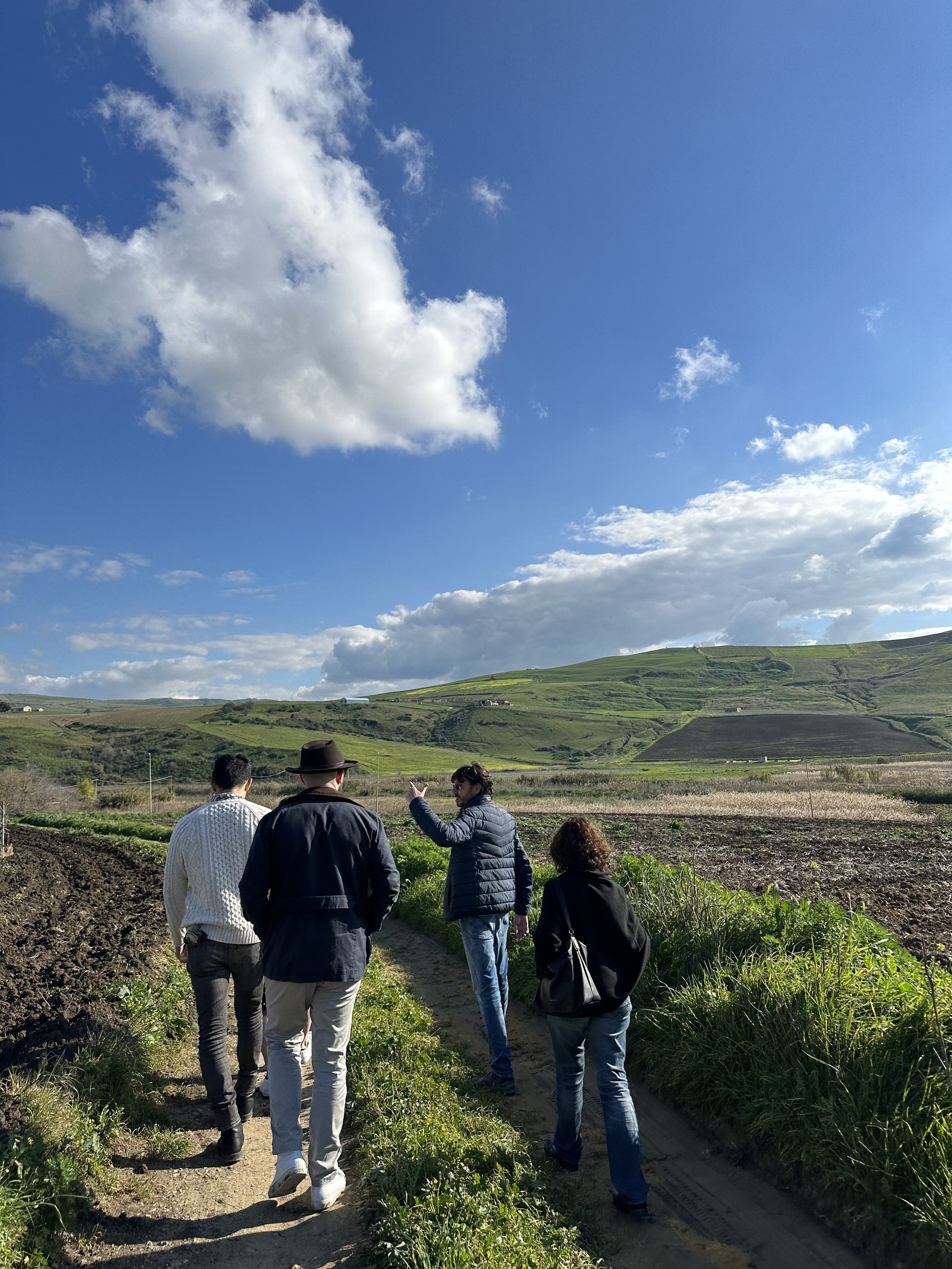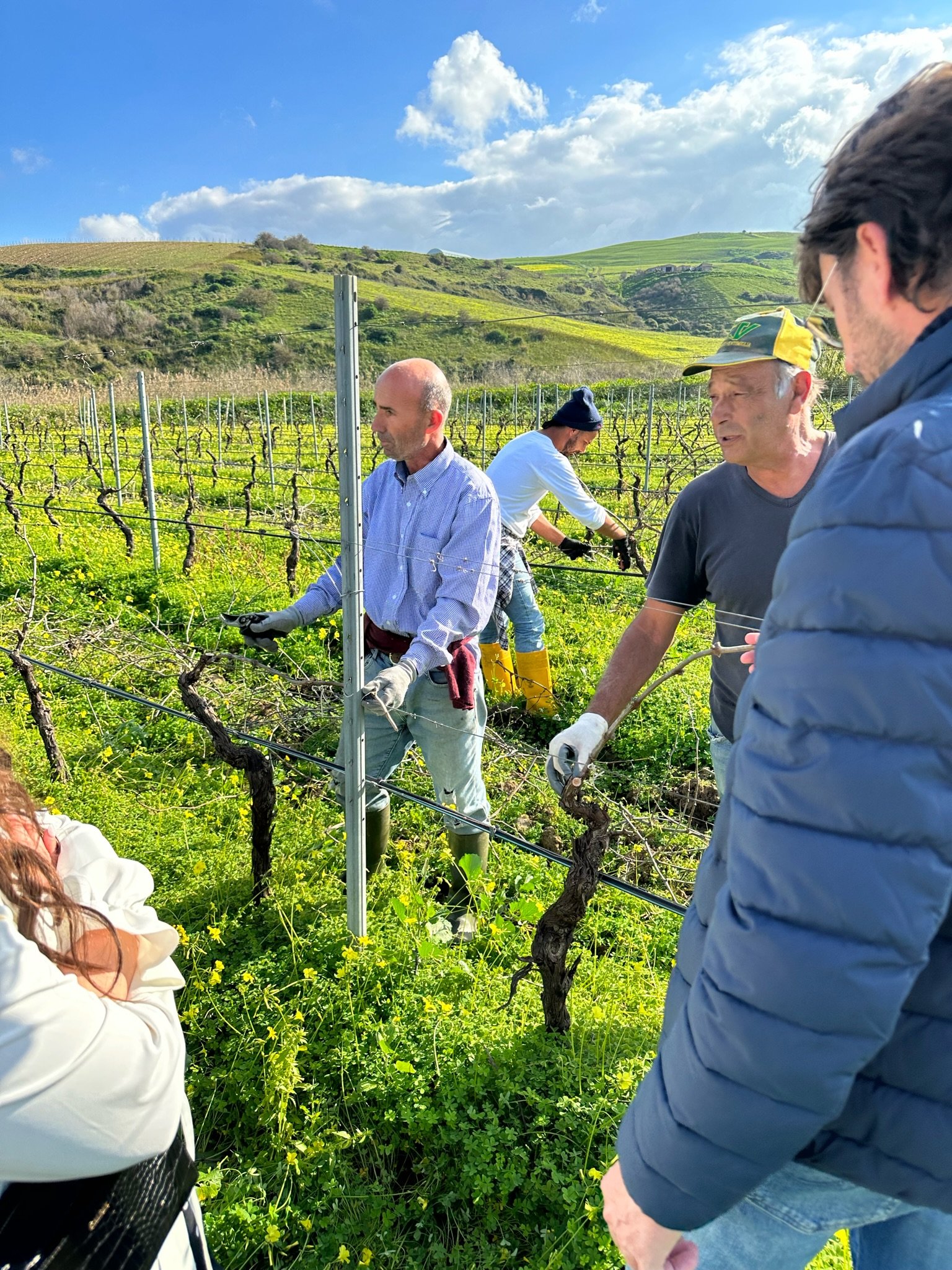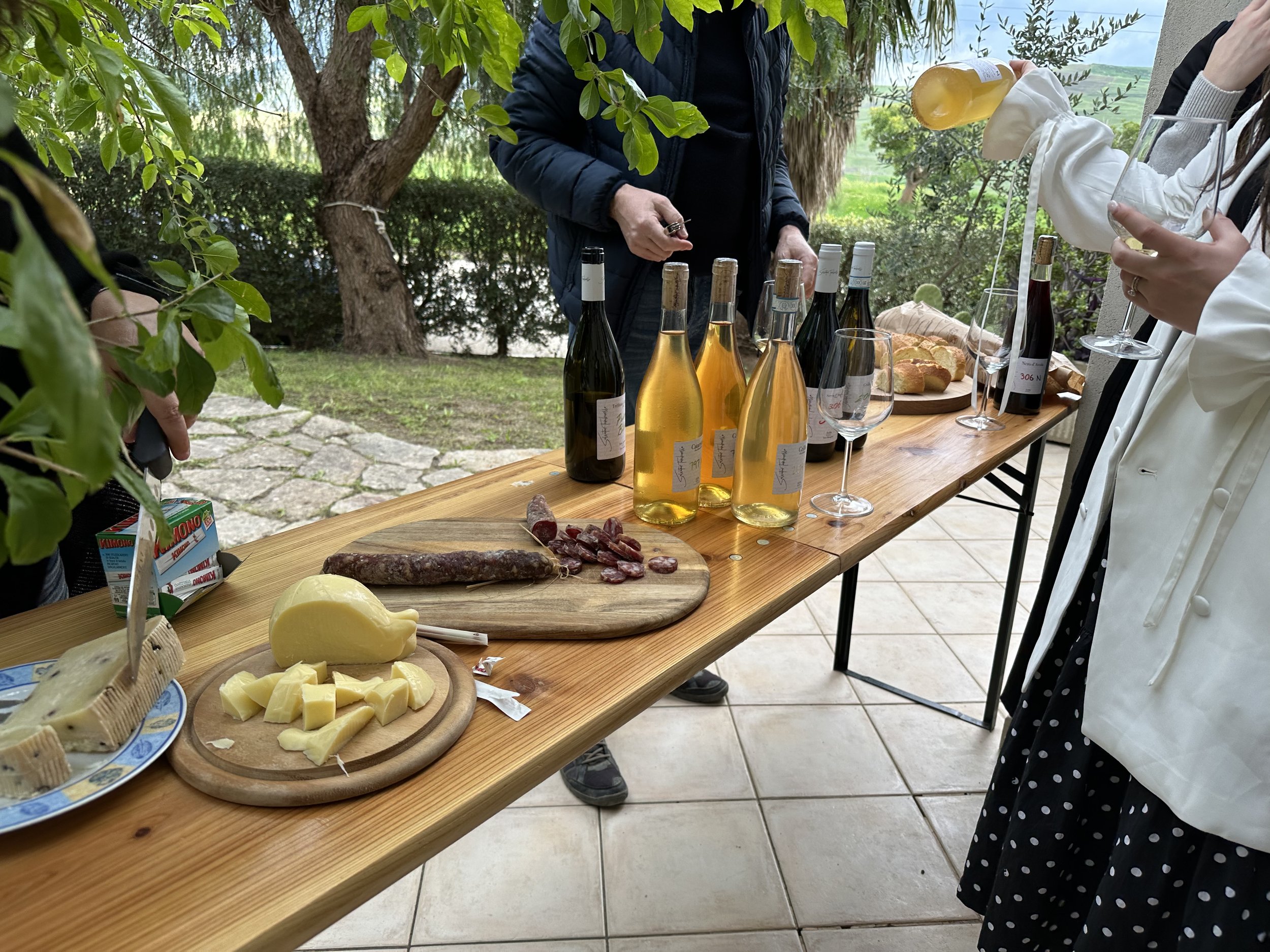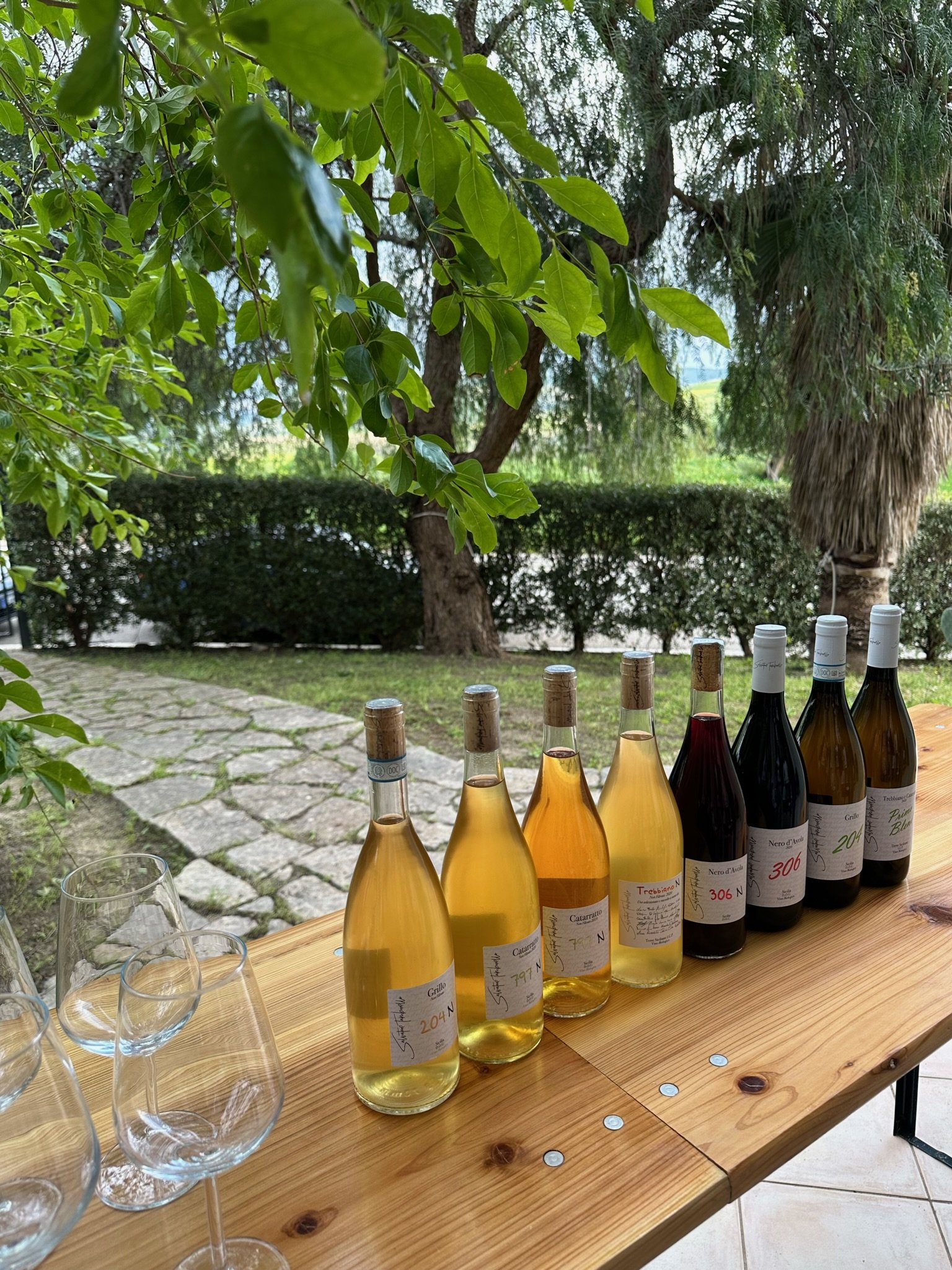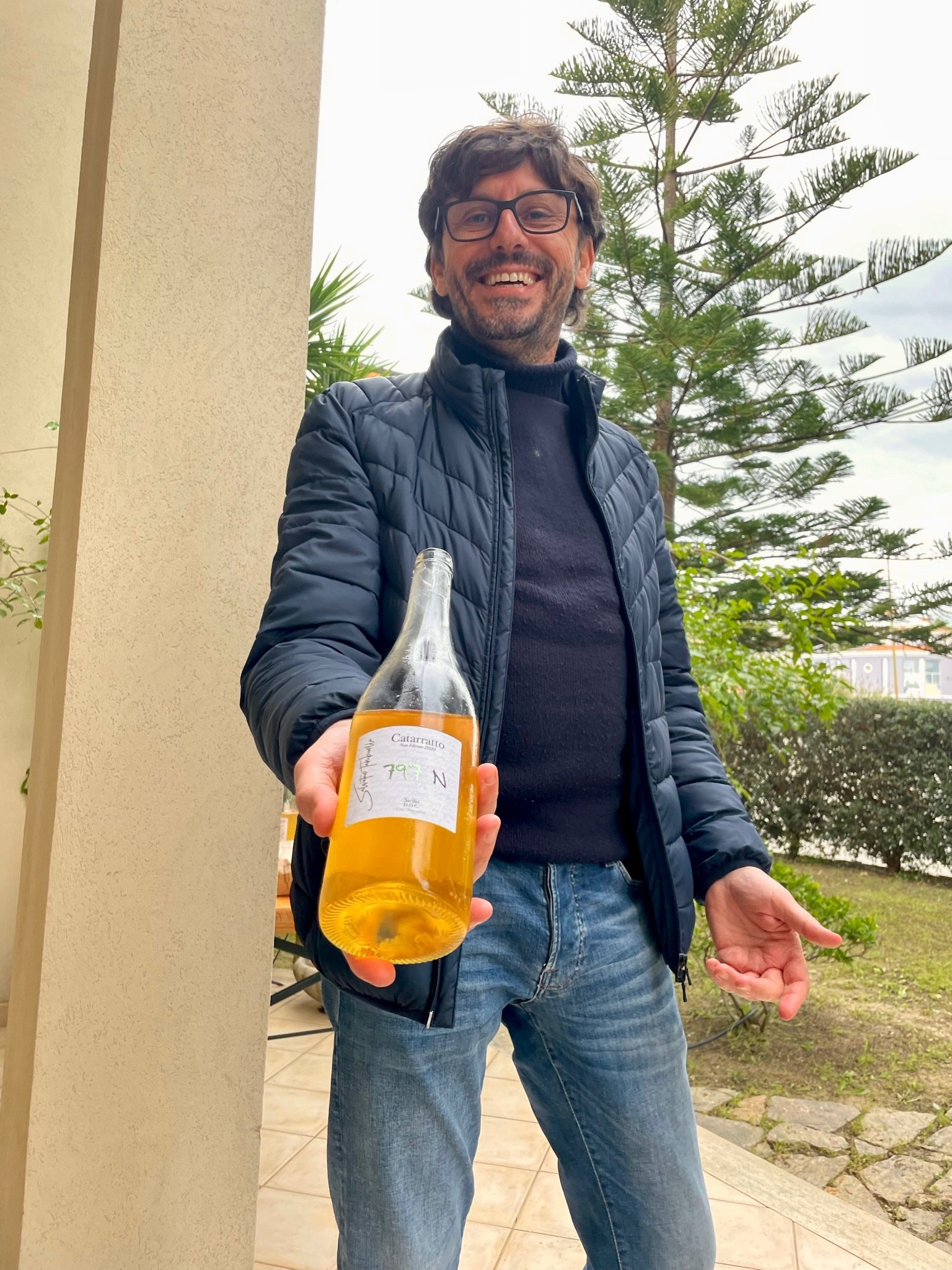Salvatore Tamburello
Walking out to Salvatore’s vineyards under perfect Sicilian skies
As we left Filari Della Rocca, we were warned. Salvatore Tamburello messaged us on WhatsApp - don’t trust google. Unfortunately, we didn’t see it until after we started down the barely existent country road in our low-clearance Fiat Panda. A few yards in, concerned we were going to be stranded deep in the Sicilian countryside, we rechecked WhatsApp to make sure we were anywhere near Salvatore and his vines.
As we make our way towards the new location he has indicated, we see an Audi pulled over on the side of the road, with the driver flagging us down. Salvatore has come to find us and spotted us meandering through the country roads.
Salvatore doesn’t have a winery. He doesn’t have a tasting room. He only has vines and wines.
He is a fifth-generation winemaker, and after spending a decade and a half making wine for other producers, he decided to start his label - quickly gaining multiple awards for his quality.
After introductions, where he kindly tells us he doesn’t speak any English, but his sister with him speaks a little, he takes us into the vineyards. At this point, it is more like a grass field. The grasses, wildflowers, and weeds are nearly knee-high and reach the bottom row of the vine trellises.
The skeleton of the vines still exists here. They have recently been pruned, but Salvatore’s team is just starting to remove the dried vines from the vineyard trellises. We stop to talk with the three workers that will cover the next 10 hectares - it will be about three weeks to hand trim all of the vineyards.
Salvatore is making Grillo, Cataratto, and Trebbiano across the vineyards in front of us in this nestled valley, and Nero D’Avola in a valley a few hills over. You could walk the perimeter of his entire vineyard in about 30 minutes. It spans a small river that isn’t labeled on any maps we could find. He purchased some of the existing Cataratto vines but planted new Trebbiano vines in 2011. He waited 8 years before he felt the quality of the new vines was strong enough to start producing wines. His first bottled vintage was in 2016.
He talks about the importance of the ecosystem as we traipse the overgrown vegetation through the vines. The bees are happy, the soil is full of organic manure, and everything that is cut from the grapes is ground back into the soil in the springtime to recycle all of the work from the vines.
Salvatore standing on the concrete pad of his future cantina - overlooking the area below where sparkling wines will be on display for visitors.
Salvatore is up and coming. He explains that the small building on the property, which resembles the hundreds of century-old buildings we’ve passed, will soon host a tasting room in the vineyard. A patio will spill out of big glass doors - this will enable future visitors to sit practically in the vineyard while enjoying his natural wines.
He takes us up to his future production facility, about 500 meters from the vineyard and slightly elevated, where the only thing that exists is two medium size concrete pads with jutting rebar, totaling roughly 3000 sqft. He paints a picture of where the walls will be, the windows, and the patio overlooking the vineyard. There will be an interior wall of glass that overlooks the aging tanks and the riddling racks where he will make his spumante (sparking wine) with the champenoise, or traditional, method (classic champagne style). Next year these will look like vertical cheese wedges with the point upwards and bottles of sparking wine jutting out of each side. 30 meters away is where everything will be produced, bottled, and labeled. The majority of the entire process - growing, harvesting, pressing, aging, bottling, labeling, and storing, will take place in a supply chain that is no more than 2 miles.
We leave the construction site and head up onto the hill and the town of Poggioreale - where Salvatore and his sister grew up.
We pull up to a new-looking development and park, quickly realizing we are tasting inside Salvatore’s house.
The Sicilian hospitality is unparalleled - sausage, cheese, fresh bread and a great line up of wines.
There is some simple lawn furniture and a wood fold-out table that Salvatore quickly covers in wine, cheese, salumi, bread, and olives (grown by Salvatore of course). How many do you we want to try? All of them? he asks. There are eight wines. and seemingly before I can answer, he says va bene, tutte, and heads inside to grab every style of wine he makes.
We are blown away by the hospitality. We are in another winemaker’s home. Being served all local products, fresh bread, and a lineup of natural wines - half of the bottles are clear so their unfiltered deliciousness can be seen before it hits the glass.
Salvatore doesn’t make every wine, every year. He only makes cru vintages, when he believes the grapes are perfect. It shows as we start our tasting. His natural wines carry the signature characteristic of opaque hues, but still hold a vibrancy of color from brilliant yellow to an almost honey gold you would expect in an aged white wine.
The breadth of Salvatore’s wines is impressive and fun.
Starting with his robust white wine - Primo Blend (Cataratto and Trebbiano). Lemon and olives come through in the flavor, and even though it is light-bodied, it is a great white for people who say they aren’t white wine drinkers. This wine has some character and density that most would traditionally associate with red wine.
Next, we have his all-natural and unfiltered Trebbiano. 17 sommeliers helped choose and cut the vines and grapes that eventually became this bottle. You are hit with orange blossoms and wildflowers, wrapped around the traditional natural wine funkiness. The wine has a light effervescence that makes it dance on your tongue.
His Grillo is filtered, but this doesn’t stop the tropical notes from jumping out of the glass. Kiwi, Key Lime, and a banana finish are balanced by a heavy dose of acidity that could compete with Pinot Grigio.
Salvatore’s full ine of white and red wines.
We won’t describe all the white wines here, but they vary in body and style. Flavors of anise, pear, and minerals are in one, while others have prominent brioche and egg custard flavors.
Everyone really enjoyed the whites, with most of us going back for seconds on all of them.
But the reds… the reds are where Salvatore is doing something special.
Salvatore makes two styles of Nero D’avola - filtered and unfiltered. The “N” on the label is almost unnecessary for differing between these two.
The unfiltered is a bright red cherry color, like a young pinot noir. The nose is fresh, with bright fruits like raspberry and the lightest touch of black currants. The wine has great acidity when young, but Salvatore says it can be aged to gain some umami and meatiness.
The filtered Nero D’Avola is a deep garnet color, partially due to the 10% in Barrique for 6 months, but also the 20 months of bottle aging. This wine has a ton of umami and berry jam, raspberry jam. Black currants really shine through as well. I could drink this every day.
Everyone makes their way back through another round of the wines, while we snack on cheese and bread. The girls are sprawled out in the hammock Salvatore has slung between two trees, and life doesn’t seem like it can get much better. Standing here overlooking the vineyard where these delectable wines were grown.
Salvatore asks us where we are heading next. Case Alte I respond. Consci?, do you know it? Over a smile, he says he will call the owner and tell him we will be late. We don’t want to leave the delicious wine and Salvatore’s easy style of sharing his creations, but it’s time to go.
Before we buy a few bottles of wine and pack up the car, Salvatore makes us promise to visit him at NOT Vini Franchi next weekend back in Palermo.
A biodynamic and natural wine symposium sounds like exactly the place we need to be.
Andiammo Tutti!


